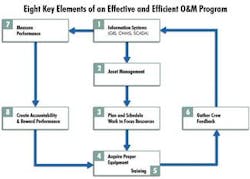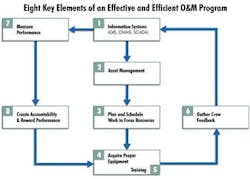Eight Steps to Improving Operation, Maintenance Programs
By Michael Flores, John Larson and Eric Wessels
In the future, collection system programs will be asked to do more with limited resources, and customers, regulatory agencies, stakeholders and policy makers will demand better service for the same cost.
Levels of service in the collection system arena are increasingly measured by the number and impact of SSOs. The good news is that organizations can quickly reduce sewer stoppages and overflows by reorganizing and optimizing their collection system operation and maintenance (O&M) programs. The primary goal is to become more efficient and effective by focusing limited resources on investigation, cleaning and repair of high-risk assets.
The key steps in creating an effective and efficient O&M program are getting the most from information systems; managing assets; focusing limited O&M resources on problem areas; using equipment properly; using feedback from crews to modify the program; measuring performance; and creating performance-based accountability and recognizing high performers.
1. Getting the Most From Information Systems— A successful O&M program lives and dies by the quality of information that is collected and analyzed. Using a number of systems – including a Computerized Maintenance Management System (CMMS), GIS and Supervisory Control and Data Acquisition (SCADA) – can help track, analyze and control critical assets.
GIS plays a vital role in mapping the location of key collection system assets, including crucial information such as the age, material and size of sewers. This information not only aids maintenance resources in knowing what to expect in the field, but it also assists in profiling the relative risks associated with that asset.
A CMMS is used to both plan and schedule work. A fully implemented system will also record and track maintenance history and warranty information, as well as other needed operational tasks.
SCADA systems track real-time data –such as where a pump station failure occurred – and they can also analyze the severity level of the failure and alert a central site that the failure occurred.
Used in concert, these systems provide powerful support to an O&M plan.
2. Managing Assets— While most O&M programs incorporate strategies to correct regulatory and capacity shortcomings, the missing elements in many of these programs is asset management – one of the best tools available to make an O&M program more efficient and effective.
Although many in the industry may be unsure of what exactly asset management means, it's relatively simple: every time a decision is made to maintain, repair, rehabilitate or replace a pipe, pump or other piece of equipment, an "asset management" function is performed.
Some key things to consider in determining if assets are being managed properly include:
• Are the business systems and practices in place needed to capture historical asset data, analyze this data and determine the reliability and cost of ownership of key system assets?
• Is this data being used to optimize the way asset maintenance, repair, rehabilitation and replacement decisions are made?
• Are these decisions systematically incorporated into the maintenance, repair and capital planning processes?
Being able to answer in the affirmative to these questions is an indicator of a good foundation to a successful, comprehensive asset management program that integrates maintenance, repair and capital programs.
An integrated program will address not only capacity and regulatory requirements, but also the deteriorating condition of aging assets.
3. Focusing Limited O&M Resources on Problem Areas— The risk of SSOs can be minimized by analyzing sewer overflow, stoppage, sewer defect information and maintenance history by asset, including pieces of pipe, manholes and pumps.
This information can then be applied to assist decision makers not only in determining optimized maintenance frequencies, but also in prioritizing repair, rehabilitation and replacement investments in the system.
4. Using Equipment Properly— Matching equipment to the job is essential for effective collection system cleaning and maintenance. A manager's job is to ensure that field crews have access to adequate equipment – both type and number.
5. Training Personnel— Part of any successful O&M program is ensuring that crews are properly trained to operate the equipment safely, productively and effectively, and focusing on the implementation of standardized work practices and "best practices" for the areas of responsibility for each crew.
Best practices include implementing a condition rating system, using an objective rating system to prioritize repairs, and refocusing the use of cleaning crews on areas with identified problems.
6. Using Feedback to Modify the Program— Knowledge in any organization is stored in the minds of employees, on paper in file drawers and electronically on computers. There is a significant value in this knowledge, and it is crucial that managers create a mechanism to capture feedback from crews that are inspecting assets, performing maintenance or responding to failures. It is also important to ensure the data is collected in such a way that it can be used to optimize an O&M program to meet the actual condition of the system.
7. Measuring Performance— It is difficult to manage something that is not measured, or as commonly expressed, "what gets measured, gets managed." A key to a successful O&M program is establishing a few critical performance measures – based upon expectations for staff performance – and a system to support their measurement over time. It is helpful to define performance measures that are SMART: Specific, Measurable, Attainable, Relevant and Time-limited. In addition, since involvement often increases commitment, it can be helpful to involve staff members when setting performance measures.
8. Creating Performance-Based Accountability and Recognizing High Performers
Once an effective way to measure performance has been developed, hold employees and work groups accountable, making sure that the best performers are both recognized and rewarded and the reasons for low performance are addressed.
About the Authors: Michael Flores is a project manager and Eric Wessels is the water/wastewater section manager in HDR's San Diego office. John Larson is HDR's engineering program manager for the state of California and works out of the Oakland office. They can be reached at [email protected] [email protected] and [email protected]. This article was previously published in Waterscapes, a technical publication of HDR.

